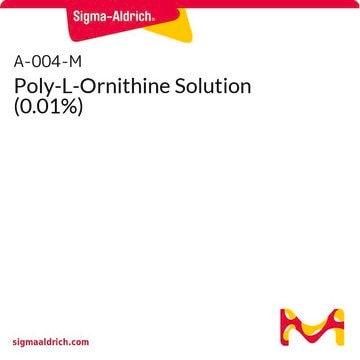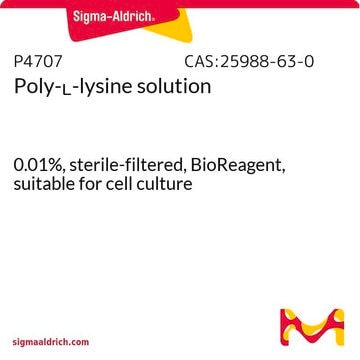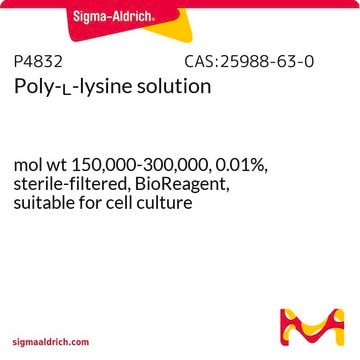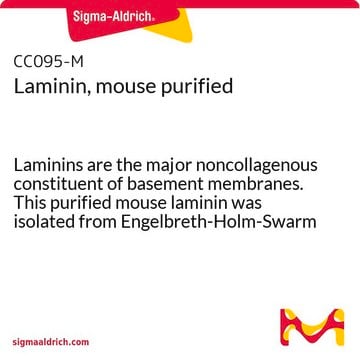P4957
Poly-ʟ-Ornithine
synthetic, mol wt 30,000-70,000, liquid, 0.01%, suitable for cell culture
Sign Into View Organizational & Contract Pricing
All Photos(1)
About This Item
CAS Number:
MDL number:
UNSPSC Code:
12352202
PubChem Substance ID:
NACRES:
NA.75
Recommended Products
Product Name
Poly-L-ornithine solution, mol wt 30,000-70,000, 0.01%, sterile-filtered, BioReagent, suitable for cell culture
biological source
synthetic
Quality Level
sterility
sterile-filtered
product line
BioReagent
form
solution
mol wt
30,000-70,000
packaging
pkg of 50 mL
concentration
0.01%
technique(s)
cell culture | mammalian: suitable
surface coverage
4 μg/cm2
impurities
endotoxin, tested
shipped in
ambient
storage temp.
2-8°C
SMILES string
Br.NCCCC(N)C(O)=O
InChI
1S/C5H12N2O2.BrH/c6-3-1-2-4(7)5(8)9;/h4H,1-3,6-7H2,(H,8,9);1H
InChI key
GWRQMKDBBHFVIZ-UHFFFAOYSA-N
General description
Poly-L-ornithine is a positively charged synthetic amino acid polymer.
Application
Poly-L-ornithine solution has been used in the induction of differentiation.
Poly-L-ornithine has been used successfully for the attachement and study of neural cell differentiation and outgrowth. Recommended as a cell culture substratum when using 0.5 ml of a 0.1 mg/ml solution to coat 25 cm2.
Biochem/physiol Actions
Poly-L-ornithine helps to improve the penetration of substances into cells. It can induce the uptake of DNA.
Preparation Note
Prepared in cell culture grade water.
related product
Product No.
Description
Pricing
Storage Class Code
10 - Combustible liquids
WGK
WGK 3
Flash Point(F)
Not applicable
Flash Point(C)
Not applicable
Choose from one of the most recent versions:
Already Own This Product?
Find documentation for the products that you have recently purchased in the Document Library.
Customers Also Viewed
Ewoud B Compeer et al.
Nature communications, 9(1), 1597-1597 (2018-04-25)
Endocytosis of surface receptors and their polarized recycling back to the plasma membrane are central to many cellular processes, such as cell migration, cytokinesis, basolateral polarity of epithelial cells and T cell activation. Little is known about the mechanisms that
Interferon (2009)
Plant Protoplasts: International Review of Cytology (2013)
Ocular Neuroprotection (2003)
Areechun Sotthibundhu et al.
EXCLI journal, 15, 829-841 (2017-03-10)
Melatonin, secreted mainly by the pineal gland, plays roles in various physiological functions including protecting cell death. We showed in previous study that the proliferation and differentiation of precursor cells from the adult mouse subventricular zone (SVZ) can be modulated
Our team of scientists has experience in all areas of research including Life Science, Material Science, Chemical Synthesis, Chromatography, Analytical and many others.
Contact Technical Service











